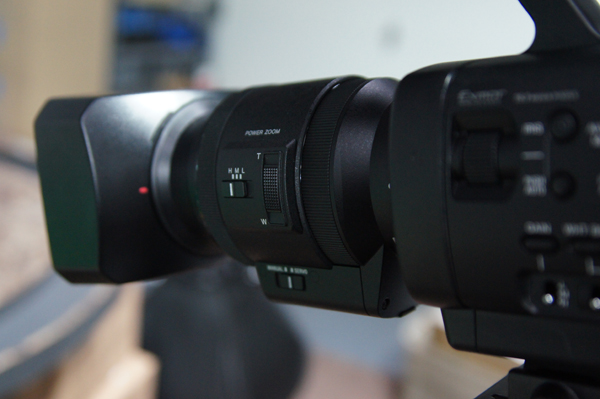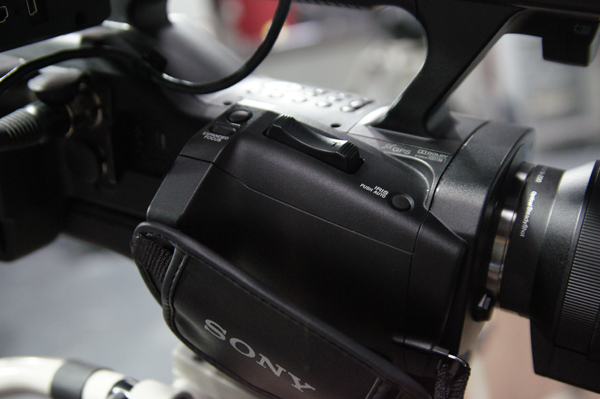Sony NEX-EA50 vs. Sony NEX-FS100 (and the Parfocal 3x+ Zoom Challenge)
Shawn Lam compares key models in Sony's large-sensor camcorder line--the new shouldermount NEX-EA50, and the comparatively venerable handheld FS100 and FS700--with an eye to light sensitivity, image quality, and effectiveness with power zoom lenses, and reports on his epic, ongoing search for a viable parfocal 3x+ servo zoom lens.
Testing the Power Zoom
I then went on to test the power zoom on the new SELP18200 lens using both the zoom rocker and the rocker on the lens itself. It responded in a very similar fashion to most camcorder servo zoom lenses and you can go into the menu and change the zoom from a pressure sensitive zoom (which I prefer) to a fixed rate zoom.

Sony SELP18200 18-200mm f/3.5-5.6 E-mount Power Zoom lens with on-lens zoom slider
Overall, I was very pleased with the servo zoom, but the EA50 has one more new zoom feature that I really wanted to test--the lossless 2x zoom on the sensor.
Because the APS-C sensor oversamples for HD video, Sony realized that if they allowed the user to zoom in on the sensor, rather than on the resulting image, it would appear lossless and would effectively let a user zoom in on a prime lens. (This is at least how they advertised the feature.) But I wanted to see if you could zoom in on a zoom lens. Why? Because I was in the midst of an unfilled lens odyssey to find a greater-than-3x zoom lens that is both parfocal, fast, and held its f-stop throughout the entire zoom range.
A "proper" Cine Zoom lens with these requirements is insanely expensive--so much so that you need a custom quotation on many of the lenses and the MSRPs are often not listed. I did find one example to demonstrate the cost: the Fujinon Zk4.7x19 19-90mm T2.9 Cabrio PL mount lens that has an MSRP of $38,000. This obviously isn't in my budget, but do you see where I'm going with this? If the EA50 could 2x zoom on the sensor when paired with a professional 3x f/2.8 DSLR lens, I could get even more focal length range for $36-37,000 less than the above lens.
Sensor-Zooming
Guess what? The EA50 can sensor-zoom any lens--prime, zoom, and even the 11x E-mount kit lens--turning it into an incredible 22x lens. In my test scene, I didn't observe any noticeable light loss when I sensor-zoomed and a very low amount of sharpness loss, although that may be perceived and it is really hard to compare the difference in sharpness between the wide and zoomed-in shot because in the former you are zooming in on pixels in order to replicate framing.
Ultimately, I would describe the sensor zoom as virtually lossless or close-enough that I can't see the difference.
Sony EA50 vs. Sony FS100: The Trade-offs
So there is your trade-off. Less light sensitivity but 2x more range on every lens. Would I buy one? I'm very seriously considering it, but I wouldn't pair it with the 18-200mm Power Zoom kit lens because that lens should only be operated at f/5.6, and that's too slow when paired with the less-light-sensitive EA50--except, of course, for outdoor shoots.
The EA50 does handle high gain well, but not as well as the FS100, so I wouldn't want to push it far into the >20 dB range. Instead of the kit lens I would pair the EA50 with a 3x f/2.8 lens in order to minimize the difference in light sensitivity and then would put the SELP18200 on the FS100 so that both cameras have some ability to zoom either on the sensor or with a servo zoom.
On E-mount cameras that lack a zoom rocker on the body, the E-mount Power Zoom lenses have a zoom slider on the lens. The lineup of Power Zoom lenses will double when Sony release a previously announced 16-50mm f/3.5-5.6 OSS power zoom, but I expect Sony will announce additional Power Zoom lenses in the future as well.
Additional Notes on the Sony NEX-EA50
As I close off this review of the Sony EA50 I wanted to note that it lacks an HD-SDI output but does offer a clean HDMI output. The viewfinder is on the left side of the body and not on the top, which I appreciate.

Sony NEX-EA50 with side-mounted LCD and optional loupe
Like the FS700, which also has its expanded focus button on the right hand side on the hand grip, I prefer it on the left side with the rest of the lens controls like on the FS100.

Sony EA50 hand grip with zoom rocker and expanded focus button
The EA50, like the FS700, has the lens mount high enough to allow for proper tripod clearance when paired with the Sony LA-EA2 A to E-mount adapter. On my FS100s, I've resorted to adding a Manfrotto quick-release base plate on top of my Vinten tripod plate in order to increase the height.
Finally, the EA50--with its slightly smaller APS-C sensor--doesn't have as shallow a depth of field as the FS100 but it's still very good, although likely not as shallow as what will be possible on the just-released Sony NEX-VG900 ($3,300 without lens) video camera that features a Super35mm sensor and will let users shoot full frame on A-mount lenses when paired with the included LA-EA3 adapter, and also has a zoom rocker.
I haven't been able to test the VG900 yet, but if you look deep into the specs on Sony's website, you'll notice that the VG900 also features a 2x digital zoom and a power zoom control--but that is another odyssey for another article, and these new developments have me wondering when the FS100 replacement will be announced and whether it too will have the 2x sensor zoom feature, or if the FS700 with a firmware update will add this feature.
Related Articles
In the last two articles in this 3-part series on the Sony a7S, we covered a lot of ground discussing what to look for in video lenses and lens adapters for the Sony e-mount that is native to the Sony a7S. Now it is time to take a deeper look at the Sony a7S as a video camera, with comparisons to the Canon 5D MKIII and Panasonic DMC-GH4.
Almost Live with Streaming Media reports from NAB 2014 with the latest on the Sony NEX-FS700R and new developments in the E-Mount lens ecosystem.
The Sony NEX-FS700 has much to recommend it as a top-flight large-sensor, interchangeable-lens camcorder and as a worth-the-upgrade successor to the Sony FS100. And it's 4k support and 10x slo-mo are nothing to sneeze at. But what makes it the best camera in the market for webcast producers?
Part 2 of this series on webcast video production focuses on Sony's NEX-FS100 large-sensor camcorder and new capabilities added via a firmware upgrade that (among other things) makes it compatible with Sony's LA-EA2 lens adapter. While it's not as strong a webcast camera as the FS700 (review coming soon), it still has much to recommend it.
An in-depth interview on Sony's new 4K-capable large-sensor camcorder that generated tremendous buzz at NAB 2012 in Las Vegas this week.